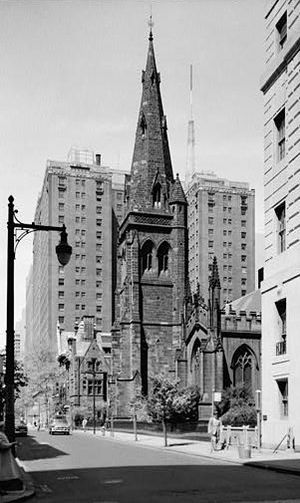St. Mark's Episcopal Church (Philadelphia) facts for kids
|
Saint Mark's Episcopal Church
|
|

Saint Mark's Episcopal Church in April 2010
|
|
| Location | 1625 Locust Street, Philadelphia, Pennsylvania, U.S. |
|---|---|
| Built | 1848 |
| Architect | John Notman Cope and Stewardson |
| Architectural style | Gothic Revival |
| NRHP reference No. | 82003815 |
Quick facts for kids Significant dates |
|
| Added to NRHP | April 19, 1982 |
| Designated NHL | February 4, 1985 |
Saint Mark's Episcopal Church is a historic church in the Rittenhouse Square neighborhood of Center City Philadelphia. As an Episcopal church, it is part of the worldwide Anglican family of churches. Because of its beautiful and important architecture, it has been named a National Historic Landmark.
Contents
History of the Church
Saint Mark's was founded in the mid-1800s during a time of religious revival. Its design was inspired by the grand churches of the Middle Ages.
Building a Gothic Masterpiece
The church was built between 1847 and 1849 in the Gothic Revival style. This style copies the look of medieval cathedrals, with features like pointed arches and tall towers. The main architect was John Notman, who based his work on a design by English architect Richard Cromwell Carpenter.
The church's impressive tower, also designed by Notman, was finished in 1865 by the architectural firm of George Hewitt.
Adding Beauty in the 20th Century
Over the years, many beautiful details were added to the church. In 1923, a new main entrance was created by architect Milton Bennett Medary. It features colorful statues showing "Christ in Majesty."
A special part of the church is the Lady Chapel, a smaller chapel dedicated to the Virgin Mary. It was designed by the firm Cope and Stewardson and built in 1900. The chapel has a stone ceiling with a special arched design called a vault. This was the first known stone vault of its kind in the United States.
The chapel and its furniture were a gift from Rodman Wanamaker, a famous local businessman, in memory of his wife.
Art and Decoration
The church is filled with amazing artwork. Many of the original decorations, including stained-glass windows, were created by the famous English artist Charles Eamer Kempe.
The Lady Chapel now has a world-famous silver altar. It is decorated with almost 150 small, hand-carved figures of saints and scenes from the life of the Virgin Mary.
Music and Bells
Music is a very important part of life at Saint Mark's. The church is known for its bells and magnificent pipe organs.
The Bells
The church's tower holds a set of eight bells made for change ringing. This is a special English tradition where bells are rung in complex patterns, not just simple tunes. The bells were made in London by the famous Whitechapel Bell Foundry in the 1870s and were restored in 1999.
The Organs
Saint Mark's has two notable pipe organs. The main organ at the front of the church was built in 1937 by Aeolian-Skinner. It was designed by G. Donald Harrison and is a great example of his "American Classic" style.
Another organ, called the screen organ, is located between the main choir area and the Lady Chapel. Parts of this instrument date back to a 1902 organ.
The Church Today
Saint Mark's is an active parish that serves its community. It holds daily church services and runs a food pantry and soup kitchen to help those in need.
In 2008, Saint Mark's took on the care of another historic church, the Church of St. James the Less. A middle school was opened on that property in 2011.
The church is led by a rector (the head priest) and a vestry (a group of elected church members who help manage the church). The Reverend Sean E. Mullen was the rector from 2006 until 2024.
See also
- List of National Historic Landmarks in Philadelphia
- National Register of Historic Places listings in Center City, Philadelphia
- Isaac Lea Nicholson
- Frank L. Vernon






